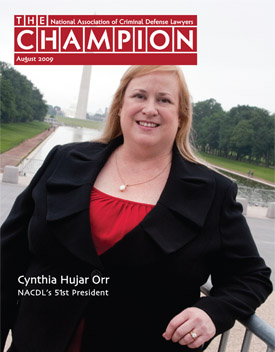Mandatory Minimum Sentencing Provisions Under Federal Law
Written Statement of Cynthia Hujar Orr, on behalf of the National Association of Criminal Defense Lawyers before the United States Sentencing Commission on May 27, 2010.
This written statement discusses the United States federal prision population and the impact of mandatory minimum sentences.
Table of Contents
- Mandatory Minimums & Systematic Disparity
- Mandatory Minimums After Booker
- Mandatory Minimums and Plea Agreements
- Congressional Alternatives to Mandatory Minimums
- Conclusion
Introduction
Thank you for allowing me to testify on behalf of the National Association of Criminal Defense Lawyers (NACDL). Aside from being NACDL‘s current president, I am a practicing criminal defense attorney at the firm Goldstein, Goldstein & Hilley, in San Antonio, Texas.
NACDL is the preeminent organization in the United States advancing the mission of the nation‘s criminal defense lawyers to ensure justice and due process for persons accused of crime or other misconduct. In keeping with this mission, NACDL supports the repeal of all mandatory minimums, greater independence for the Sentencing Commission to formulate the Sentencing Guidelines, and maximum discretion for sentencing judges to tailor sentences to the specific offenses and offender.
Of great concern to NACDL are our nation‘s rate of imprisonment and overall prison population, which is the highest of any industrialized nation, and the closely related problem of overly harsh federal penalties for nonviolent drug offenses. As the Pew Center on the States recently reported, the number of state prisoners declined in 2010 – for the first time in nearly 40 years. This decrease, however, was more than offset by the continued growth of the federal prison population.1
Stubbornly, our federal prison population continues to grow even as the crime rate decreases.2 There are currently about 211,000 prisoners in our federal prisons, a greater than three – fold increase since 1990 (59,000) and 60 percent increase since 2000 (131,000). Given that drug offenders account for more than half of federal prisoners (yet only 30 percent of federal defendants sentenced), the severe impact of mandatory minimum sentences cannot be denied. As the Pew report explains, “the federal system has tougher sentencing laws, more restrictive supervision policies and fewer opportunities for diversion of defendants.” Although the federal prison population currently is operating at 37% above its rated capacity, the solution is not to build more prisons.
Rather, a civilized society must find alternatives to imprisonment to deal with conduct that it wishes to prevent, particularly in the case of nonviolent offenses. While public support for mandatory minimums has been called into question, support for prison alternatives has grown. A 1998 poll conducted by StrategyOne for Families Against Mandatory Minimums (FAMM) found that 78 percent of Americans agree that courts – not Congress – should determine an individual‘s prison sentence and nearly 60 percent oppose mandatory minimum sentences for nonviolent offenders.3 By comparison, another poll, Raising the Topic of Race: Analysis of a national survey on race, crime, drugs and justice, by Belden, Russonello & Stewart, found that the majority of Americans support community service and drug treatment over more prisons. NACDL recently released a report on drug courts, in which we surmised, ?Much of the support for drug courts ultimately turns on heir existence as the sole, or best, alternative to draconian punishment. 4
NACDL has long maintained that the goals of sentencing—retribution, deterrence, incapacitation, and rehabilitation—are not well served by inflexible and frequently disproportionate mandatory minimum penalties. Mandatory minimums for drug offenses focus on the amount of drugs to the near exclusion of all other factors relating to culpability. This has resulted in the imposition of disproportionately harsh sentences on those who are merely peripheral agents of drug kingpins and middlemen, a feature that has drawn harsh criticism by those within the criminal justice community and persistent calls for reform. As then Congressman George Bush said forty years ago in introducing legislation to repeal federal mandatory minimums for drug offenses, ?Philosophical differences aside, practicality requires a sentence structure which is generally acceptable to the courts, to prosecutors, and to the public.5 The Sentencing Commission is undertaking this report a a time when growing public and legislative interest in alternatives to incarceration has created a unique educable moment regarding mandatory minimum sentences.
1. Mandatory Minimums & Systematic Disparity
Mandatory minimums have produced systematic disparity that is incongruous with the goals of the Sentencing Reform Act of 1984 (SRA), the United States Sentencing Commission, and the criminal justice system as a whole. These systematic disparities are most pronounced in the treatment of drug offenders, and include: (1) offender disparity, (2) racial disparity, and (3) the disparate impact on women.
A. Offender Disparity: Mandatory Minimums Treat Different Offenders the Same and Similar Offenders Differently
Mandatory minimums have produced a system where differently situated offenders are treated the same and similarly situated offenders are treated differently. First, the draconian application of mandatory minimums, and the strict limits on deviating from those sentences, cause low-level participants in the criminal conduct to be treated the same or more harshly than the major principals. The broad reach of conspiracy laws and the minimal requirements for criminal intent, allow individuals who have had limited contact with the criminal activity to be treated the same as those driving the criminal enterprise. However, unlike those major players, low-level offenders frequently lack the knowledge and ability to qualify for a sentence below the mandatory minimum under the ?substantial assistance provision in 18 U.S.C. § 3553(e).
Conspiracy laws are broad in nature and allow individuals with minimal culpability to be punished for all the acts of every other individual within the conspiracy. ?Proving a conspiracy requires that each person be a member of the alleged conspiracy and that there be an agreement between the members to achieve an illegal goal with knowledge of the conspiracy‘s overall goal.6 However, the conspiracy laws are particularly problematic when applied to individuals who have familial or intimate relationships with major participants in the criminal enterprise. This is because a person‘s ?familial or intimate relationship with a drug trafficker may suggest that she is knowingly involved in the conspiracy. . . . [and] the use of vicarious liability allows the overt acts of others to be imputed to [that person.]7 Certain innocent acts such as taking a phone call, permitting the presence of drugs in the home, or driving a family member to a location without knowledge of the purpose of the visit, can establish a person‘s part within a conspiracy and make him or her liable for the actions of all others in the conspiracy.
Mandatory minimums exacerbate the breadth of the conspiracy laws by locking judges into sentences without any consideration of the individual‘s circumstances, level of involvement and/or culpability. Although 18 U.S.C. § 3553 provides exceptions to the imposition of a mandatory sentence, low-level offenders are frequently unable to qualify for application of these exceptions.
The first exception, commonly referred to as the safety valve, allows the sentencing judge to waive the mandatory minimum for certain non-violent, low-level drug offenders who satisfy the five statutory requirements.8 Unfortunately, the safety valve‘s first three requirements— criminal history, possession of a dangerous weapon, and the death or serious injury of a person— render the exception inapplicable to those many low-level offenders, due to relatively minor criminal history or liability for the acts of others within the conspiracy. The safety valve‘s fifth requirement also is problematic, inasmuch as it has been interpreted by the courts to require an admission of guilt. The safety valve is meant to mitigate the draconian imposition of mandatory minimums on low-level players – not to require them to admit guilt and waive meritorious appeal issues. The Commission should clarify that offering all information regarding the offense does not require an admission of guilt.
The second exception, found in 18 U.S.C. § 3553(f), allows the sentencing judge to impose a sentence below the mandatory minimum, upon a motion of the government, for the offender‘s ?substantial assistance in the investigation or prosecution of another person who has committed an offense. Under this exception, however, many high-level offenders are able to avoid the mandatory minimum by providing substantial assistance, while low-level offenders lack the necessary knowledge to satisfy the requirement and qualify for the exception. This ?cooperation paradox is especially visible in drug cases where low-level co-conspirators, who have little or no information to provide the government, end up with far more severe sentences than leaders of conspiracies who run the operations and know the other participants.9
When the breadth of conspiracy law and the limited exceptions provided by 18 U.S.C. §3553 combine with harsh mandatory minimum laws that restrict all judicial discretion, offenders who are different in virtually every regard—role, criminal history, culpability—are treated the same. Even worse, in many cases, those who are more culpable are treated better than those low-level, minor participants. Conversely, as observed by this Commission in its 1991 Report, ?[j]ust as mandatory minimums fail to distinguish among defendants whose conduct and prior records in fact differ markedly, they distinguish far too greatly among defendants who have committed offense conduct of highly comparable seriousness.10 This phenomenon, known as the ?cliff effect of mandatory minimums, is caused by rigid, as opposed to gradual, offense definitions.
B. Racial & Ethnic Disparities: Mandatory Minimums Exacerbate Pre-Existing Unwarranted Disparities
Sentencing policies and law enforcement practices which operate in a racially disparate manner erode public confidence in our criminal justice system, particularly in minority communities. As the Brennan Center recently observed, ?The federal criminal sentencing system is notorious both for its overall severity and for its disproportionate impact on people of color.11 The Sentencing Commission first reported increasing racial disparities in August 1991:
The difference found across race appears to have increased since 1984. This difference develops between 1986 and 1988, after implementation of mandatory minimum drug provisions, and remains constant thereafter.12
Racial and ethnic disparities continue today and are seen at all stages of the criminal justice process. For example:
In its 1995 Annual Report, the Commission noted, ?Traced over time, the relative proportion of Whites in the defendant population has steadily declined since 1990, while increasing considerably for Hispanics.13 This trend has continued. Currently Hispanics comprise 15 percent of the general population but 45 percent of the federal defendant population and 33 percent of the federal prison population.
By 2003, Blacks were serving nearly as much time in prison for a drug offense (58.7 months) as Whites for a violent offense (61.7 months).14
In 1999, 39 percent of those receiving mandatory sentences were Hispanic, 38 percent were African American, and 23 percent were white . . . . Although in 1999 African Americans and Hispanics were only 24.7 percent of the population, they comprised 77 percent of those who received mandatory minimum sentences and nearly 90 percent of the individuals given mandatory life sentences by the U.S. Government.15
In addition, the enhanced mandatory minimum penalties for the crack form of cocaine continue to be one of the primary causes of disparity. Federal statistics indicate that more than 40% of crack users are White, yet last year 79% of individuals convicted of crack offenses were Black.16 As the Sentencing Commission‘s 1995 crack cocaine report pointed out, this form of cocaine is the only drug where the penalties are inverted so that bulk importers and distributors of the powder form of cocaine, the basic ingredient for making crack cocaine, receive more lenient sentences than the street dealer.
One of the causes of this racial disparity again seems to lie at the transfer of power to federal prosecutors that allows them to control departures below mandatory minimum sentences. In its 1991 report to Congress, the Sentencing Commission found that substantial assistance departures that allow judges to sentence below the mandatory minimum were more likely to be granted to Whites than to Blacks or Hispanics. This disparity could not be accounted for by considerations related to the nature of the offense and the prior criminal record of the defendant.17 In fact, the Sentencing Commission was unable to identify any relevant factors— such as the severity of the offense or the extent of the cooperation—that would explain the disparity.
These findings were confirmed in a 1998 study by Sentencing Commission staff, which found that the data ?raise questions of racial, ethnic, nationality, and gender disparities in the awarding of K5K1.1 motions.18 This study also found that ?compared to a non-minority defendant and controlling for all other personal, judicial, and guideline factors in the model, a Hispanic defendant was seven percentage points less likely than a non-Hispanic defendant to receive a substantial assistance departure.19
Mandatory minimums are primarily imposed for drug offenses and statistics demonstrate that people of color are disproportionately prosecuted for drug offenses. These two facts create an environment ripe for racial disparity in mandatory minimum sentencing. Mandatory minimums are then applied, or not applied, in a manner that ensures the risk of discriminatory impact becomes reality.20
C. Mandatory Minimums Disparity Impact Women and Have Destructive Effects on Children
Mandatory minimums disparately impact women and have a destructive impact on their children, making them collateral victims of the mother‘s incarceration. ?Between 1980 and 2002, the number of women in state and federal prisons has increased from 12,300 to more than 96,000. The number of women incarcerated for drug trafficking reached a record high of 6.8% of all offenders in 2002.21 ?The ‘war on drugs’ has had a huge impact on women [and] is the primary cause of the increased number of mothers incarcerated, which harms children more than when a father is incarcerated.22
Combined with conspiracy laws, mandatory minimums have a disparate effect on a certain category of women who have contact with criminal activity as a result of an intimate relationship, typically characterized as abusive or financially dependent, with a drug trafficker. Because these laws focus solely on the acts—such as answering a telephone or permitting the presence of drugs in the home—rather than the underlying circumstances, the role of a woman in her partner‘s drug activity can be exaggerated. As one scholar notes, ?the wife of a white-collar criminal is usually shielded from her husband‘s criminal activity. The wife or live-in companion of a drug dealer who sells his wares on the streets or from the home is not equally sheltered‘ [and is] more vulnerable to being labeled as an active participant in the crime.23
Similar to other low-level offenders, these women lack the necessary knowledge about the drug conspiracy to qualify for the substantial assistance exception to a mandatory minimum sentence under 18 U.S.C. 3553(e). Further, even if these women have information to provide, they typically face a greater risk of harm, exacerbated by their financial dependence or cultural pressure to keep their family together, for themselves and their family by cooperating.
The rigidness of mandatory minimums and the inability of judges to consider other circumstances in the sentencing of these women have a significantly destructive impact on their children. ?Almost 70% of all incarcerated women are mothers, and their children have been left with little protection and little hope. For every mother that is in prison, another 10 people (children, caretakers, grandparents, siblings, and fathers) are directly impacted.24 Unlike when a male offender with children is incarcerated, children are frequently left parentless when the mother is incarcerated. ?This is mainly because ninety percent of children are cared for by their mothers during a father‘s imprisonment, whereas only twenty-eight percent of children whose mothers are incarcerated remain in their father‘s care.25 Thus, a female incarceration frequently results in children being transferred to state custody and, typically, the termination of that mother‘s parental rights.
These children are the collateral consequences of the rigid application of mandatory minimums, which do not allow for consideration of the women‘s role in the drug conspiracy or the effect incarceration will have on her family. ?Children of incarcerated women are likely to suffer from multiple psychological problems, including trauma, anxiety, shame, fear, and guilt.26 These problems manifest in other negative behavior, such as low self esteem, truancy, and self destructive behavior. ?More disturbing is that children of incarcerated parents have a greater risk of becoming offenders themselves. . . . [One] study found that forty-five percent of all children arrested between the ages of nine and twelve had incarcerated parents.27 This familial cycle of incarceration magnifies the destructive impact of mandatory minimums sentencing and underscores the need for reform.
II. Mandatory Minimums After Booker
Sentencing practices following Booker do not provide justification for mandatory minimum penalties. As compared to the initial increase in below-range sentences (non- government sponsored) after Booker, the increase has not been significant in the past four years. In 2009, 15.9 percent of sentences were below the applicable Guidelines range; this is still well below the 20 percent rate contemplated by Congress when it enacted the Sentencing Reform Act.
In fact, the changes wrought by Booker have brought greater urgency to the need to repeal mandatory minimums, which remain the most conspicuous obstacle to fairness in federal sentencing. They stand in the way of the grant of appropriate variances for with no reasonable justification. The sought-after quantity-based uniformity fails to fulfill any meaningful purpose, as drug amount is frequently not a matter under the control of the person being sentenced. Many times it is fixed by the whim of law enforcement agents making the request for drugs or offering the sale of drugs in a sting operation.
Variances do not create unwarranted disparity — they are the hallmark of a just system of punishment. Departures account for offense and offender differences that if disregarded, would create disparity. Although the Sentencing Guidelines include what are arguably the most prominent offense and offender characteristics, they are by necessity a relatively blunt instrument; without variances, they would frequently fail to take account of ethically relevant differences between offenders.
Moreover, to the extent that judges, prosecutors, and defense attorneys are relying upon variances in response to overwhelming caseloads or unduly blunt guidelines, enacting more mandatory minimums will only drive sentencing evasion underground and camouflage the root problems. There are many other mechanisms for evading mandatory minimums, including charge bargaining and fact bargaining, which escape detection and resist policing.
III. Mandatory Minimums and Plea Agreements
Mandatory minimums have transferred discretion, authority and responsibility from constitutional officers, the judges of the lower federal courts, to persons who have no express constitutional role, the prosecutors, who are hired without the careful scrutiny given to federal judges. In doing so, mandatory minimums disrupt our system of checks and balance by placing unchecked power in the hands of men and women whose decisions are made in the privacy of their offices, who are caught up in an adversarial role, and whose public function often serves as a stepping stone to higher political or judicial office.
A. Sixth Amendment Right to A Fair Trial
The risk of being sentenced under mandatory minimums effectively precludes defendants from exercising their Sixth Amendment right to a trial. The right to have a neutral, third party review the evidence and facts is fundamental to the foundation of our criminal justice system. However, even if a defendant has minimal culpability or a strong defense, faced with a mandatory minimum sentence of ten or more years, a defendant will almost always forego his right to a trial. Prosecutors have unlimited discretion over charging decisions and, therefore ?the power to deter the accused from exercising their right to a fair trial by application of mandatory sentencing schemes[.]28
A recent case in the Eastern District of New York illustrates the problematic effect mandatory minimums have on a defendant‘s right to a fair trial, as well as, the disapproval of mandatory minimums by the judges and jurors alike.29 After convicting the defendant on various child pornography charges, the court engaged in a conversation with the jurors about the charges. ?All of the jurors who spoke when invited to do so by the court acknowledge the defendant‘s mental illness, recognized his need for mental health treatment, and believed imprisonment was not called for.30 The court informed the jurors of the five-year mandatory minimum sentence and ?those jurors who evinced an opinion declared they would have voted to find the defendant not guilty by reason of legal insanity, causing a mistrial, had they known of the mandatory minimum.31
As the post-conviction proceedings moved forward, one of the questions considered by the court was whether to inform the jury, before deliberations, of the five-year mandatory minimum sentence required to be imposed upon a finding of guilt on certain charges. Guiding the court‘s decision making process was the Sixth Amendment right to be tried by a jury informed of the full effect of its verdict. The court reviewed the history of the Sixth Amendment and noted, in particular, that the ?right to a trial by jury incorporated in the Constitution by the Sixth Amendment was envisaged as a check against overreaching by the new federal government.32 Historically, the jury had the ability to downsize their verdicts, a practice similar to jury nullification. The court concluded that, ?[t]o fully exercise their historical function, juries today must understand the implications of their decision in a case such as the present one [requiring imposition of a mandatory minimum] and, as such, the court has the discretion to inform the jury of the mandatory minimum.33
B. The High Rate of Plea Agreements and the Lack of Transparency
The rate of offenders accepting plea agreements, rather than exercising their right to a trial, has steadily increased since the 1990s. In 1995, 91.7% of all offenders and 90.1% of all drug offenders accepted a plea agreement. Last year, 96.3% of all offenders and 96% of all drug offenders accepted a plea agreement.34 With nearly all federal offenders accepting plea agreements, the manner in which these agreements are established and executed should be transparent. However, federal prosecutors have chosen to exercise this extraordinary power in a very secretive and effectively unreviewable manner.
In plea agreements, federal prosecutors reserve onto themselves the absolute power to determine whether the defendant has provided substantial assistance. At the same time, federal prosecutors refuse to spell out in writing the magical quantum of assistance which will satisfy them that a defendant has sufficiently cooperated and is to be rewarded with the departure motion. In some districts, the decision is further insulated from review and disclosure because it is made by Departure Committees made up of prosecutors whose names are not disclosed and whose deliberations are kept secret. A defendant can only challenge the decision if he can prove that it was made with unconstitutional motive or in bad faith. Such claims are nearly impossible to prove in any case but are particularly difficult to prove where the decision is made behind closed doors. Once again, it is difficult to reconcile this reality with Congress‘ intent to make sentencing fair and uniform and open.
Further exacerbating this process is the ease with which prosecutors can charge up a defendant in order to extract a significantly longer sentence as part of the plea agreement. As discussed earlier, the federal conspiracy laws allow prosecutors to charge even those actors who have minimal ties to the conspiracy for all the criminal conduct of the conspiracy. In addition, many federal criminal laws are drafted in such a vague and imprecise manner that prosecutors are able to charge a variety of offenses, and hang them over the offender‘s head, even if those charges may not be satisfied at trial or upheld on appeal. Because the charging process is completely controlled by the prosecutor and there is virtually no review, prosecutors use the threat of mandatory minimums to extract plea agreements.
Prosecutors frequently require, as an express plea agreement condition, that defendants waive their right to request a downward departure or other sentencing adjustment as well as their right to appeal the sentence imposed. Indeed, the government‘s increased requirement that defendants waive all manner of claims of error including wrongful conduct — such as ineffective assistance of counsel claims and failure to disclose exculpatory evidence by the government — contributes to the problem of innocent persons being convicted and minor participants serving inappropriately long sentences.
IV. Congressional Alternatives to Mandatory Minimums
In the current 111th Congress, with several months remaining, legislators have introduced 19 bills containing at least one mandatory minimum sentence of imprisonment, ranging from 6 months to 25 years. Looking back as far as the 104th Congress, spanning the last 15 years, the number of mandatory minimum bills introduced each Congress has remained relatively high, ranging from 20 to 57, and does not reveal a consistent downward trend.35 Granted, this is only one measure of congressional support for mandatory sentencing, but it does suggest a dogged adherence to polices that have been roundly criticized by this Commission, the judiciary, academics, the press, and other observers.
Congress has requested that the Commission include in its report a ?discussion of mechanisms other than mandatory minimum sentencing laws by which Congress can take action with respect to sentencing policy. In its 1991 report, the Sentencing Commission encouraged Congress to use statutory directives, as an alternative to mandatory penalties, to express its views regarding sentencing policy for certain offences. Directives may be mandatory or discretionary, specific or general, and in its 1991 report, the Commission expressed a clear preference for directives that are discretionary and general.
Generally, Congress uses directives to express dissatisfaction with what it perceives as inappropriately low Sentencing Guidelines ranges for particular offenses. The current Congress is instructive: So far, in the 111th Congress, nineteen bills have been introduced that contain directives to the Sentencing Commission, almost all of which would amend the Guidelines upward. Eight of these bills would require that the Commission amend the Guidelines, while eleven would direct the Commission to consider amendments. Of the bills that require amendment, three specifically prescribe the amount of the increase.
While certainly preferable to mandatory minimums, this practice has tended to continue the one-way upward ratchet of federal sentences. Too often, Congress directs the Sentencing Commission to increase penalties based on anecdotal media reports without sufficient verifiable scientific and empirical evidence. These directives carry undeniable weight with the Commission, resulting in guideline increases that were not otherwise perceived as necessary and diverting the Commission‘s resources from its carefully identified priorities. In addition, the Sentencing Guidelines, whatever its flaws, are an integrated system. This micro-management of the guidelines by Congress not only contributes to the ratcheting up of sentences, it undermines the uniformity and fairness that Congress sought to bring into federal sentencing. Congress has directed the Sentencing Commission to increase penalties for particularized factors, and these directives have often duplicated guideline provisions that already punish such factors.
The Commission‘s 1991 recommendations are still sound and warrant repetition in its updated report. In particular, the Commission should emphasize that general directives, providing the Commission with some discretion to consider whether and how to amend the Guidelines, are the only way to preserve the consistency, fairness and integrity of the system. In our experience, the sponsors of mandatory minimum legislation or overly specific directives do not first consult with the Commission to determine if any empirical data supports the conclusion that current sentences are inappropriate. We urge the Commission to take an active role in educating members of Congress, particularly those who have introduced mandatory minimum legislation, about the negative effects of mandatory minimums and the unique role of the Sentencing Commission in formulating rational and consistent sentencing policies.
NACDL and the Heritage Foundation recently released the report Without Intent: How Congress Is Eroding the Criminal Intent Requirement in Federal Law, and one of the recommendations in that report is relevant here. Based on our statistical analysis, we recommended that Congress ?require every bill that would add or modify criminal offenses or penalties to be subject to automatic sequential referral to the relevant judiciary committee. As we explained, ?[t]he judiciary committees alone have the special expertise required to properly draft and design criminal laws. Additionally, this rule would force Congress ?to adopt a measured and prioritized approach to criminal lawmaking. While we did not specifically study the effect of Judiciary Committee referral on sentencing policy, it stands to reason that judiciary committee members and staff will be more familiar with the complexities of the Sentencing Guidelines and the unintended consequences of mandatory minimum sentences.
V. Conclusion
I would like to conclude with a question posed ten years ago by NACDL‘s then President William Moffitt, who passed away last year. In testifying on mandatory minimums before the House Government Reform Committee, Mr. Moffitt asked: ?when will our society be unable to pay, fiscally, for incarcerating our own? When will our society be unable to cope with our bloated prison population? When will our very fabric crumble as the hundreds of thousands of individuals who we have locked away for five, ten or twenty years, return to our midst, unenlightened and disfranchised. Reversing course and avoiding these circumstances will not be easy, but this Commission can help lead the way by unequivocally reaffirming its principled and pragmatic opposition to mandatory minimums.
Footnotes:
1. Prison Count 2010: State Population Declines for the First Time in 38 Years, The Pew Center on the States (April 2010). back
2. Federal Bureau of Investigation, Crime in the United States, Preliminary Annual Uniform Crime Report, May, 24, 2010 (last visited May 24, 2010). back
3. Families Against Mandatory Minimums Omnibus Survey. back
4. National Association of Criminal Defense Lawyers, America’s Problem-Solving Courts: The Criminal Costs of Treatment and the Case for Reform (2009). back
5. 116 Cong. Rec. H33314, Sept. 23, 1970. back
6. Chieko M. Clark, Maternal Justice Restored: Redressing the Ramifications of Mandatory Sentencing Minimums on Women and Children, 50 How. L.J. 253, 267 (2006). back
7. Shimica Gaskins, “Women of Circumstance” – The Effects of Mandatory Minimum Sentencing on Women Minimally Involved in Drug Crimes, 41 Am. Crim. L. Rev. 1533, 1537 (2004). back
8. 18 U.S.C. 3553(e). back
9. Gaskins, supra note 7, at 1544back
10. United States Sentencing Commission, Special Report to Congress: Mandatory Minimum Penalties in the Federal Criminal Justice System 82, 30-31 (1991) [hereinafter 1991 Report]. back
11. Brennan Center for Justice, Racial Disparities in Federal Prosecutions, 10 (2010) [hereinafter Brennan Report]. back
12. 1991 Report, supra note 11, 82. back
13. U.S.S.C., Annual Report 46 (1995). See also U.S.S.C., Annual Report 33 (1996). back
14. Compendium of Federal Justice Statistics, 2003, tbl. 7.16, at 112.back
15. Id. back
16. U.S.S.C., 2009 Sourcebook of Federal Sentencing Statistics, tbl. 34 (2010). back
17. 1991 Report, supra note 11, at ii, 82, 89. back
18. U.S.S.C., Substantial Assistance: An Empirical Yardstick Gauging Equity in Current Federal Policy and Practice 14 (1998). back
19. Id. (The report setting forth these findings notes ?that several variables expected to have great explanatory power [such as information concerning district charging practices, plea bargaining practices, and more detailed infor mation on the type and usefulness of information] were not available as input into the model.). back
20. Anecdotal evidence from a report done by the Brennan Center for Justice demonstrates the consideration of race in prosecutorial decision making. Specifically, one former U.S. Attorney recounted the following:back
I had an [Assistant U.S. Attorney (?AUSA) who] wanted to drop the gun charge against the defendant [in a case in which] there were no extenuating circumstances. I asked, ?Why do you want to drop the gun offense? and he said, ?He is a rural guy who grew up on a farm. The gun he had with him was a rifle. He is a good ol‘ boy, and all the good ol‘ boys have rifles, and it‘s not like he was a gun-toting drug dealer. But he [was] a gun-toting drug dealer, exactly.
As the report notes, ?[i]n that case, the question of whether to dismiss a gun charge carrying a statutory mandatory minimum sentence turned on the prosecutor‘s perception of the defendant‘s culpability, which was in turn informed in part by race. Brennan Report, supra note 12, at 11.
21. Gaskins, supra note 7, at 1533. back
22. Clarke, supra note 6, at 266. back
23. Gaskins, supra note 7, at 1538. back
24. Clarke, supra note 6, at 271. back
25. Id. back
26. Id. at 272. back
27. Id. at 272-73. back
28. Ogletree, supra note 7, at *6. back
29. U.S. v. Polouizzi, 2010 WL 318265 (E.D.N.Y.) (2010). back
30. Id. at *18.back
31. Id. back
32. Id. at *36. back
33. Id. at *20, 50, 78. back
34. U.S.S.C, 2009 Sourcebook of Federal Sentencing Statistics, tbl. 11 (2010) ; U.S.S.C, 1995 Sourcebook of Federal Sentencing Statistics, tbl. 11 (1996). back
35. An effort to tally the number of mandatory minimum bills introduced during the past 7 Congresses (going back 15 years) revealed the following: 104th Congress (1995-96): 47; 105th Congress (1997-98): 33; 106th Congress (1999- 2000): 26; 107th Congress (2001-02): 20; 108th Congress (2003-04): 28; 109th Congress (2005-06): 57; 110th Congress (2007-08): 44. back












